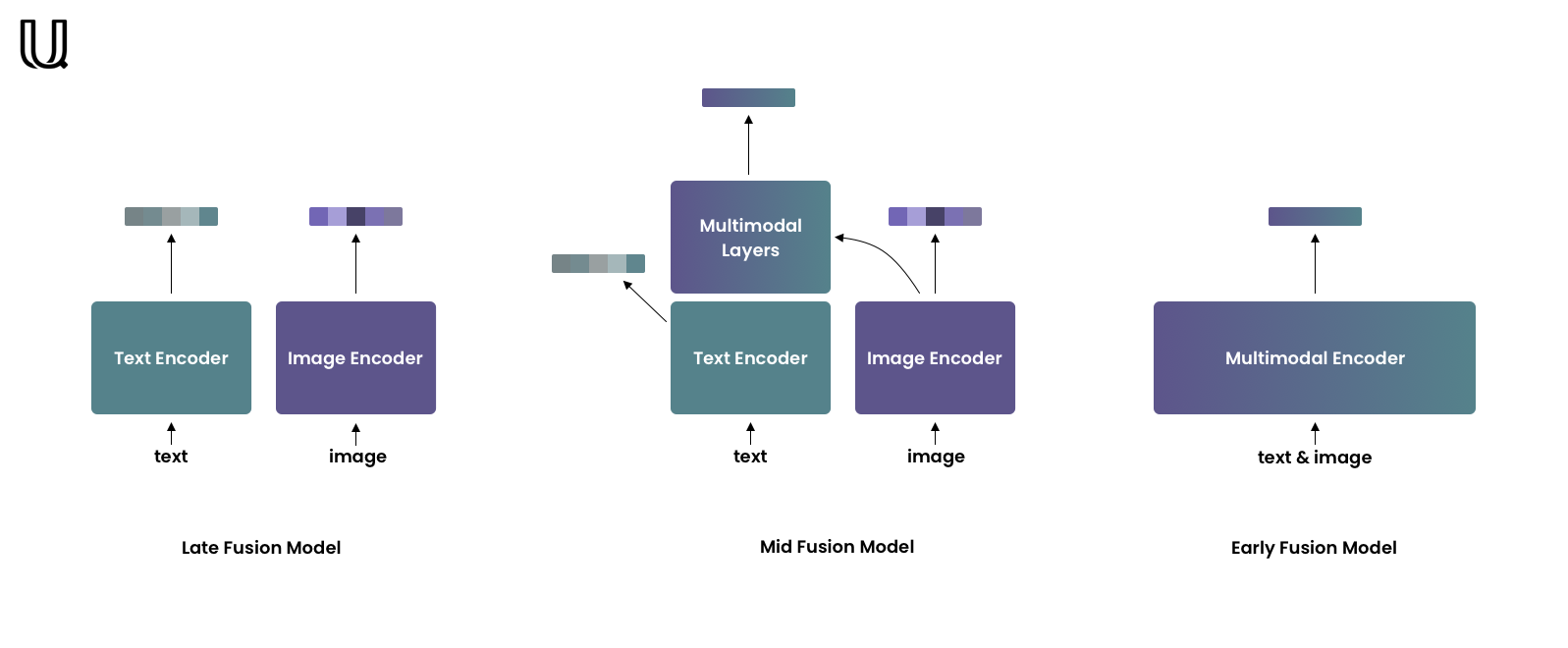Multi-Modal Transformers library for Semantic Search and other Vision-Language tasks
Project description
UForm
Multi-Modal Transformers Library
For Semantic Search Applications
UForm is a Multi-Modal Modal Inference package, designed to encode Multi-Lingual Texts, Images, and, soon, Audio, Video, and Documents, into a shared vector space!
It comes with a set of homonymous pre-trained networks available on HuggingFace portal and extends the transfromers package to support Mid-fusion Models.
Three Kinds of Multi-Modal Encoding
Late-fusion models encode each modality independently, but into one shared vector space. Due to independent encoding late-fusion models are good at capturing coarse-grained features but often neglect fine-grained ones. This type of models is well-suited for retrieval in large collections. The most famous example of such models is CLIP by OpenAI.
Early-fusion models encode both modalities jointly so they can take into account fine-grained features. Usually, these models are used for re-ranking relatively small retrieval results.
Mid-fusion models are the golden midpoint between the previous two types. Mid-fusion models consist of two parts – unimodal and multimodal. The unimodal part allows encoding each modality separately as late-fusion models do. The multimodal part takes unimodal features from the unimodal part as input and enhances them with a cross-attention mechanism.
This tiny package will help you deal with the last!
Installation
pip install uform
Usage
To load the model:
import uform
model = uform.get_model('unum-cloud/uform-vl-english')
model = uform.get_model('unum-cloud/uform-vl-multilingual')
You can also load your own Mid-fusion model. Just upload it on HuggingFace and pass model name to get_model.
To encode data:
from PIL import Image
text = 'a small red panda in a zoo'
image = Image.open('red_panda.jpg')
image_data = model.preprocess_image(image)
text_data = model.preprocess_text(text)
image_embedding = model.encode_image(image_data)
text_embedding = model.encode_text(text_data)
joint_embedding = model.encode_multimodal(image=image_data, text=text_data)
Retrieving features is also trivial:
image_features, image_embedding = model.encode_image(image_data, return_features=True)
text_features, text_embedding = model.encode_text(text_data, return_features=True)
These features can later be used to produce joint multimodal encodings faster, as the first layers of the transformer can be skipped:
joint_embedding = model.encode_multimodal(
image_features=image_features,
text_features=text_features,
attention_mask=text_data['attention_mask']
)
Remote Procedure Calls for Cloud Deployments
You can also use our larger, faster, better proprietary models deployed in optimized cloud environments. For that, please, choose the cloud of liking, search the marketplace for "Unum UForm" and reinstall UForm with optional dependencies:
pip install uform[remote]
The only thing that changes after that is calling get_client with the IP address of your instance instead of using get_model for local usage.
model = uform.get_client('0.0.0.0:7000')
Evaluation
There are two options to calculate semantic compatibility between an image and a text: Cosine Similarity and Matching Score.
Cosine Similarity
import torch.nn.functional as F
similarity = F.cosine_similarity(image_embedding, text_embedding)
The similarity will belong to the [-1, 1] range, 1 meaning the absolute match.
Pros:
- Computationally cheap.
- Only unimodal embeddings are required, unimodal encoding is faster than joint encoding.
- Suitable for retrieval in large collections.
Cons:
- Takes into account only coarse-grained features.
Matching Score
Unlike cosine similarity, unimodal embedding are not enough.
Joint embedding will be needed and the resulting score will belong to the [0, 1] range, 1 meaning the absolute match.
score = model.get_matching_scores(joint_embedding)
Pros:
- Joint embedding captures fine-grained features.
- Suitable for re-ranking - sorting retrieval result.
Cons:
- Resource-intensive.
- Not suitable for retrieval in large collections.
Models
Architecture
| Model | Language Tower | Image Tower | Multimodal Part | URL |
|---|---|---|---|---|
| English | BERT, 2 layers | ViT-B/16 | 2 layers | weights.pt |
| Multilingual | BERT, 8 layers | ViT-B/16 | 4 layers | weights.pt |
The Multilingual model supports 11 languages, after being trained on a balanced dataset. For pre-training we used translated captions made with NLLB.
| Code | Language | # | Code | Language | # | Code | Language |
|---|---|---|---|---|---|---|---|
| eng_Latn | English | # | fra_Latn | French | # | kor_Hang | Korean |
| deu_Latn | German | # | ita_Latn | Italian | # | pol_Latn | Polish |
| ita_Latn | Spanish | # | jpn_Jpan | Japanese | # | rus_Cyrl | Russian |
| tur_Latn | Turkish | # | zho_Hans | Chinese (Simplified) | # | . | . |
Performance
On RTX 3090, the following performance is expected from uform on text encoding.
| Model | Multilingual | Sequences per Second | Speedup |
|---|---|---|---|
bert-base-uncased |
No | 1'612 | |
distilbert-base-uncased |
No | 3'174 | x 1.96 |
MiniLM-L12 |
Yes | 3'604 | x 2.24 |
MiniLM-L6 |
No | 6'107 | x 3.79 |
uform |
Yes | 6'809 | x 4.22 |
Project details
Release history Release notifications | RSS feed
Download files
Download the file for your platform. If you're not sure which to choose, learn more about installing packages.












